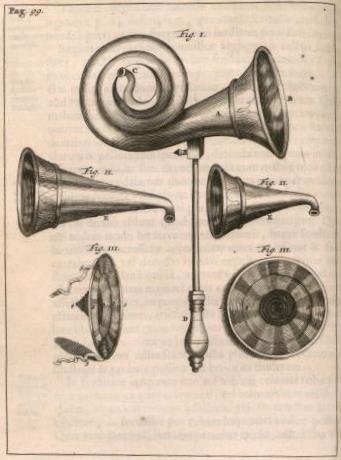
We may take it as a given that our hearing aids are barely noticeable, can be controlled with our cell phones, and can distinguish between speech and background sound. What we might not realize, however, is that those capabilities are the products of 400 years of experiment, design, and enhancement.
Even 5 years ago, hearing aids could not deliver the clarity of sound generated at present. To see why, let’s track the history of hearing aids—starting today and travelling in reverse—to see how hearing aids would have treated your hearing loss in four different years: 2016, 1985, 1940, and 1650.
2016 – Modern Digital Hearing Aids
It’s 2016 and you’re searching to address your hearing loss. You open up an internet browser, search for a local hearing care provider, fill out a brief form, and schedule an appointment.
At your hearing test, your hearing is evaluated using sophisticated computer technology that accurately assesses your hearing. Then, with the assistance of your hearing care practitioner, you select a hearing aid that meets your needs from an extensive selection of models.
Then, your hearing practitioner programs your new hearing aids to enhance only the sounds and frequencies you have difficulty hearing, bringing about crystal clear sound without distortion.
If you were to tell anyone in the 1980’s that this would be the process, they wouldn’t have believed it was possible.
So what did render it possible? In a nutshell, digital technology.
For most of their history, there was no way for hearing aids to discern between different sound frequencies. Hearing aids would enhance all incoming sound, including background noise, generating distorted sound.
The digital revolution solved that challenge. With digital technology, all information can be altered, stored, and manipulated as combinations of 0’s and 1’s. Digital technology made it possible for hearing aids to convert sound frequencies into digital information, which could then be characterized based on which sounds should be amplified (speech) and which should be suppressed (background noise).
The first all-digital hearing aid was produced in 1995, and since then the technology has improved exponentially, ultimately to include wireless capability.
1985 – Transistor Hearing Aids
Now, imagine it’s 1985 and you’re looking to treat your hearing loss. You can forget searching for a local hearing care provider on the internet because the first commercial internet service provider won’t be founded until 1989.
You’d have to use the phone book, depend on recommendations, or drive around the neighborhood to find a hearing care practice.
After scheduling an appointment and having your hearing analyzed, your choices for hearing aids are very limited. Without the microprocessor and digital technology, hearing aids were engineered with a series of transistors. This adds size and higher power requirements, resulting in larger batteries and larger hearing aids.
Also, without the advantage of digital technology, the hearing aid can’t distinguish between different frequencies of sound. Hearing aids receive inbound sound and the transistors function as basic amplifiers, amplifying all sound. So if you’re in a noisy area, speech recognition will be nearly impossible.
1940 – Vacuum Tube Hearing Aids
It’s 1940 and you’re interested in purchasing a hearing aid. Transistors haven’t been applied to hearing aids yet, so your choices are limited to vacuum tube hearing aids.
Vacuum tubes consume more power than transistors, so the hearing aids call for larger batteries, making the hearing aids big, heavy, and awkward.
And once again, without digital technology, the hearing aids can only act as simple amplification devices, making all inbound sound louder. The hearing aids cannot enhance speech and can’t filter out background noise.
1650 – Ear Trumpets
Let’s travel all the way back to 1650. There’s no digital technology, no transistors, and no vacuum tubes. As a result, there is no way to convert sound into electrical currents that can be amplified.
With electrical amplification out of the question, your only option is mechanical amplification by focusing and compressing sound into the ear canal, much like what happens when you cup your hands around your ears.
By 1650, gadgets were developed that focused incoming sound into the ears, and these contraptions were named ear trumpets. They were prominent gadgets with a conical end that picked up sound and a narrow end that concentrated the sound into the ear.
This would be the only technology obtainable to individuals with hearing loss for the following 250 plus years.
Let’s return to 2016. Over more than 400 years of history, hearing aids have evolved from mechanical amplification devices to electrical amplification devices, from vacuum-tube-based to digital-based. They’ve come to be significantly more compact, lighter, and more effective and affordable.
They’ve also become better at differentiating among different types of sound, and in amplifying only specific kinds of sound (like amplifying speech while repressing background noise).
Every generation of hearing aid has generated a major enhancement over the previous generation. The question is, what’s the next great milestone in the history of hearing aids?
Will we soon be able to enhance natural human hearing, rather than simply restore it?

